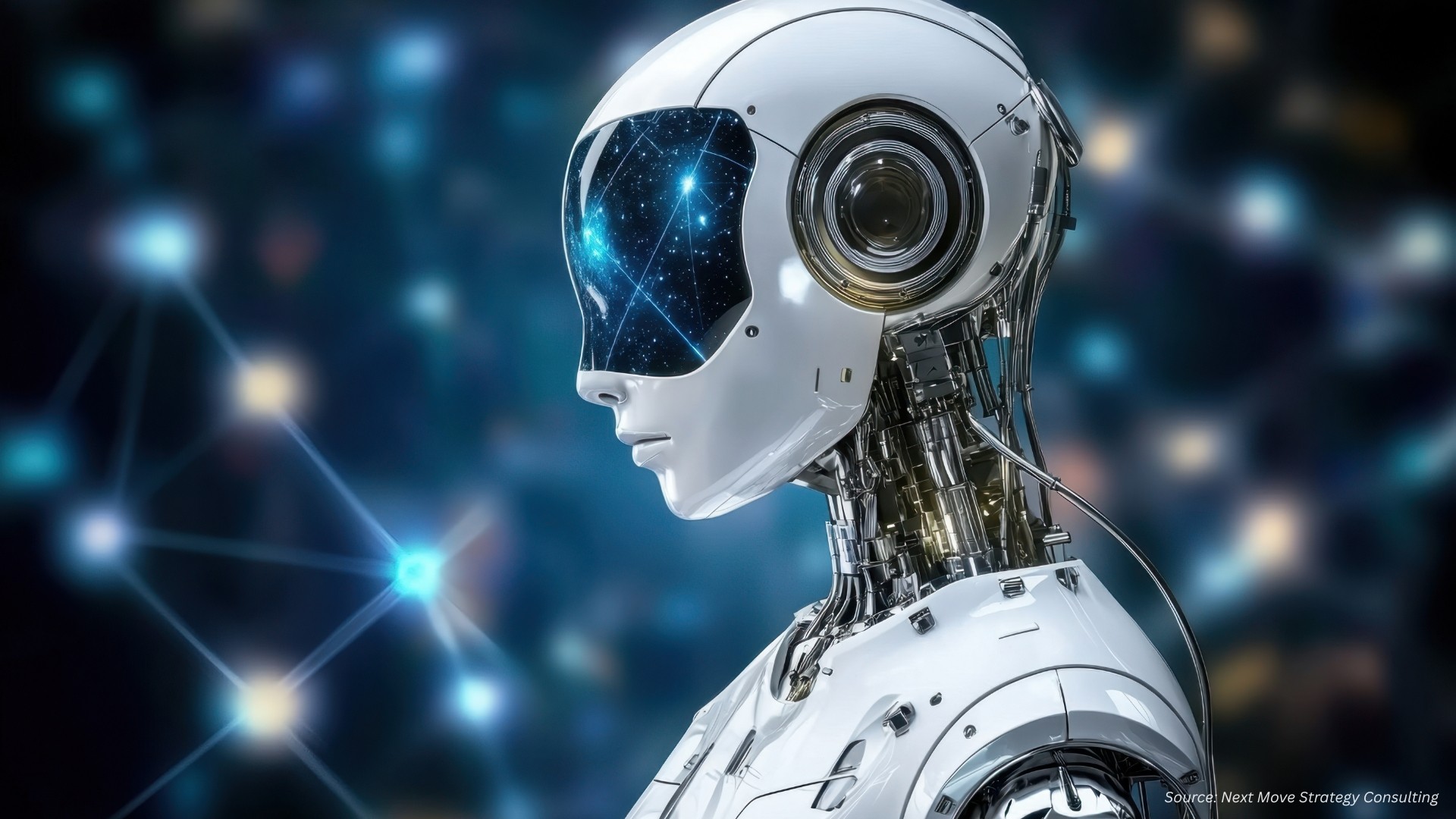Why AI Robots Are Revolutionizing Technology
Published: 2025-09-16

Introduction
Artificial intelligence (AI) robots are robots that are designed to perform tasks that typically require human-like intelligence, such as understanding language, learning and adapting to new situations, and making decisions.
These robots have the ability to handle the complexity of massive data and provide high accuracy and quick processing solutions to advance science and technology. There is a growing demand for artificial intelligence in robotics owing to automation in the manufacturing, automotive, and industrial sectors companies are assessing the long-term income potential to complete repetitive jobs more effectively and autonomously.
AI robots are being used in a variety of applications, including manufacturing, healthcare, and customer service. They can also be used in search and rescue operations, space exploration, and military operations. However, the development of AI robots also raises ethical and societal concerns, including the potential for job displacement and the need for responsible AI development and regulation.
Types of AI Robots
There are various different types of AI robots that have been developed for a variety of applications. Some common types of AI robots include:
Industrial robots: These robots are used in manufacturing and other industrial settings to perform tasks such as welding, painting, and assembly. Industrial robots are typically designed to work alongside humans, and are often equipped with safety features such as sensors and barriers to prevent accidents.
Source: Next Move Strategy Consulting
Service robots: Service robots are designed to perform tasks that require human-like intelligence, such as customer service or home care. These robots may be equipped with sensors, cameras, and machine learning algorithms to enable them to understand and respond to their environment.
Impact of Advanced Technologies on Global AI Robots
Computer vision and machine learning are important technologies that have significantly impacted the development of artificial intelligence (AI) robots.
Computer vision involves the use of algorithms and machine learning techniques to enable a computer to interpret and understand visual data from the world around it. This enables robots to perceive and understand their environment, a critical capability for many AI robots. For instance, self-driving cars use computer vision to navigate roads and avoid obstacles, while service robots in hospitals and hotels use computer vision to navigate through corridors and identify objects in their environment.
Machine learning is a subset of artificial intelligence that involves the use of algorithms to enable a system to learn from data and improve its performance over time without explicitly being programmed. Machine learning techniques are often used to enable robots to learn new tasks and adapt to changing environments. For instance, robots in manufacturing environments might use machine learning to learn how to perform different tasks, while robots used in search and rescue operations might use machine learning to learn how to navigate through complex terrain.
Overall, the combination of computer vision and machine learning has had a significant impact on the development of AI robots by enabling them to perceive and understand their environment, learn new tasks, and adapt to changing situations.
Current Scenarios of AI Robots in Big Economies
United States has utilized AI robots for military and defense purposes for several years. Numerous drones are used in a variety of commercial contexts, including media and entertainment, precision agriculture, law enforcement, inspection, and surveys. The rising need for professional service robots with AI integration, particularly for medical and underwater applications. Moreover, the increasing usage of automated material handling, lights-out automation, and warehouse automation, as well as the increased adoption of these robots across a variety of industries in the U.S. accelerates the demand for robots. The market is also expanding due to companies' increasing innovation in AI-based robots for inventory management that scan products to reduce errors in various industries. The increasing safety awareness and concern in sensitive and restricted areas to maintain an autonomous inspection 24/7 to eliminate uncertain scenarios.
China has quickly adopted robotics as a result of a number of factors such as China is able to build robots at a lower cost than the majority of other countries due to its strengths and manufacturing efficiency. Additionally, the government is actively promoting the sector to assist China's emergence as a high-tech giant and to meet anticipated labor shortages brought on by its increasingly aging population. According to the Chinese Institute of Electronics (CIE), China’s robotics industry was worth USD 12.12 billion in 2021. Where industrial robots were worth USD 6.44 billion, while service robots were worth USD 5.68 billion. As per Wang Hong, an official at the Ministry of Industry and Information Technology (MIIT), China produced 366,000 robots, an increase of 67.9 percent compared to the previous year. In the first half of 2022, however, China produced 202,000 units. Several government initiatives regarding the development of robotic industry contribute significantly to the growth of the AI robot market. According to the International Federation of Robotics, the 5-year plan for the robotics industry in China, released by the Ministry of Industry and Information Technology (MIIT) in Beijing, focused on promoting innovation for making China a global leader in robot technology and industrial advancement. The pharmaceutical and automotive industry in China is also deploying robots in their factories to support workers, enhance efficiency and minimize human errors. Moreover, the integration of AI-based robots in many industries such as gaming, healthcare, and others for performing operations. China is also intensely including AI-based robots such as robot dogs, drones, and others for accomplishing its military purpose.
Competitive Landscape
There are numerous companies that are engaged in the manufacturing of AI robots, Leading players are fortifying their positions through a range of strategies, including the introduction of new products, partnerships, collaboration, acquisitions, and company growth.
Next Move Strategy Consulting recognizes at least 5 biggest players in the market including IBM, Intel, Microsoft, NVIDIA, and Softbank.
Source: Next Move Strategy Consulting
About the Author
 Shyam Gupta is a passionate and highly enthusiastic researcher with more than four years of experience. He assists clients in overcoming difficult business challenges by providing actionable insights through exhaustive research. He has been closely monitoring a number of industries, such as Consumer Electronics, Robotics, and Electric Vehicles. He has a keen interest in writing articles and uses blogs as a medium to share his thoughts. He spends his time reading and painting, when not keeping up with industry news.
Shyam Gupta is a passionate and highly enthusiastic researcher with more than four years of experience. He assists clients in overcoming difficult business challenges by providing actionable insights through exhaustive research. He has been closely monitoring a number of industries, such as Consumer Electronics, Robotics, and Electric Vehicles. He has a keen interest in writing articles and uses blogs as a medium to share his thoughts. He spends his time reading and painting, when not keeping up with industry news.
About the Reviewer
 Debashree Dey is a skilled Content Writer, PR Specialist, and Assistant Manager with strong expertise in Digital Marketing. She specializes in crafting visibility strategies and delivering impactful, data-driven campaigns. Passionate about creating engaging, audience-focused content, she helps brands strengthen their online presence. Beyond work, she draws inspiration from creative projects and design pursuits.
Debashree Dey is a skilled Content Writer, PR Specialist, and Assistant Manager with strong expertise in Digital Marketing. She specializes in crafting visibility strategies and delivering impactful, data-driven campaigns. Passionate about creating engaging, audience-focused content, she helps brands strengthen their online presence. Beyond work, she draws inspiration from creative projects and design pursuits.
















Add Comment